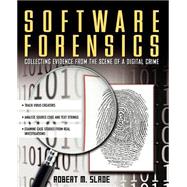
What is included with this book?
| Introduction | xi | ||||
| 1 Introduction to Software Forensics | 1 | (22) | |||
|
2 | (3) | |||
|
4 | (1) | |||
|
5 | (6) | |||
|
6 | (5) | |||
|
11 | (1) | |||
|
12 | (6) | |||
|
12 | (2) | |||
|
14 | (2) | |||
|
16 | (2) | |||
|
18 | (2) | |||
|
18 | (1) | |||
|
19 | (1) | |||
|
20 | (1) | |||
|
21 | (1) | |||
|
21 | (2) | |||
| 2 The Players-Hackers, Crackers, Phreaks, and Other Doodz | 23 | (22) | |||
|
24 | (19) | |||
|
26 | (3) | |||
|
29 | (6) | |||
|
35 | (2) | |||
|
37 | (5) | |||
|
42 | (1) | |||
|
43 | (2) | |||
| 3 Software Code and Analysis Tools | 45 | (20) | |||
|
47 | (4) | |||
|
51 | (1) | |||
|
52 | (1) | |||
|
53 | (11) | |||
|
63 | (1) | |||
|
64 | (1) | |||
| 4 Advanced Tools | 65 | (12) | |||
|
65 | (3) | |||
|
67 | (1) | |||
|
68 | (1) | |||
|
68 | (1) | |||
|
68 | (2) | |||
|
69 | (1) | |||
|
70 | (6) | |||
|
71 | (5) | |||
|
76 | (1) | |||
| 5 Law and Ethics-Software Forensics in Court | 77 | (14) | |||
|
77 | (3) | |||
|
78 | (1) | |||
|
79 | (1) | |||
|
80 | (7) | |||
|
80 | (1) | |||
|
81 | (3) | |||
|
84 | (3) | |||
|
87 | (3) | |||
|
88 | (1) | |||
|
89 | (1) | |||
|
90 | (1) | |||
| 6 Computer Virus and Malware Concepts and Background | 91 | (22) | |||
|
91 | (4) | |||
|
95 | (9) | |||
|
98 | (2) | |||
|
100 | (1) | |||
|
101 | (2) | |||
|
103 | (1) | |||
|
103 | (1) | |||
|
104 | (1) | |||
|
104 | (8) | |||
|
106 | (5) | |||
|
111 | (1) | |||
|
112 | (1) | |||
| 7 Programming Cultures and Indicators | 113 | (16) | |||
|
113 | (3) | |||
|
116 | (4) | |||
|
120 | (2) | |||
|
122 | (5) | |||
|
122 | (2) | |||
|
124 | (2) | |||
|
126 | (1) | |||
|
127 | (1) | |||
|
127 | (2) | |||
| 8 Stylistic Analysis and Linguistic Forensics | 129 | (18) | |||
|
130 | (1) | |||
|
131 | (3) | |||
|
134 | (12) | |||
|
137 | (2) | |||
|
139 | (5) | |||
|
144 | (1) | |||
|
145 | (1) | |||
|
146 | (1) | |||
|
146 | (1) | |||
| 9 Authorship Analysis | 147 | (8) | |||
|
147 | (3) | |||
|
148 | (2) | |||
|
150 | (2) | |||
|
150 | (1) | |||
|
151 | (1) | |||
|
152 | (1) | |||
|
153 | (2) | |||
| References and Resources | 155 | (50) | |||
|
156 | (10) | |||
|
166 | (8) | |||
|
174 | (16) | |||
|
190 | (1) | |||
|
190 | (6) | |||
|
196 | (5) | |||
|
201 | (1) | |||
|
202 | (3) | |||
| Index | 205 |
The New copy of this book will include any supplemental materials advertised. Please check the title of the book to determine if it should include any access cards, study guides, lab manuals, CDs, etc.
The Used, Rental and eBook copies of this book are not guaranteed to include any supplemental materials. Typically, only the book itself is included. This is true even if the title states it includes any access cards, study guides, lab manuals, CDs, etc.